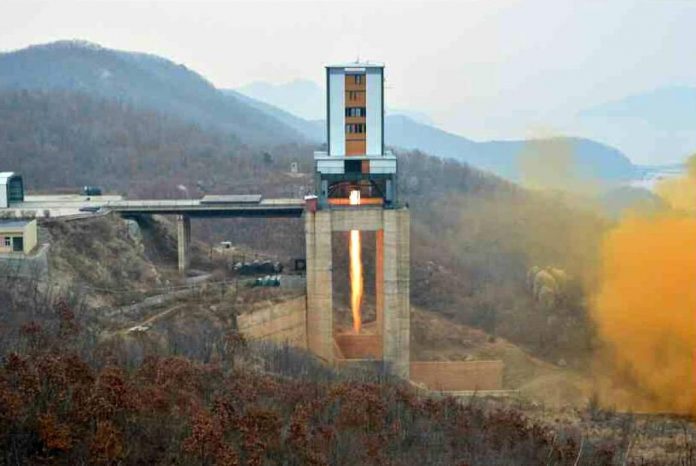
TOKYO – Kim Jong Un has presided over a rocket engine test “of historic significance,” North Korean state media said Sunday, a test that coincided with U.S. Secretary of State Rex Tillerson’s visit to neighboring China.
The young North Korean leader declared “that the whole world will soon witness what eventful significance the great victory won today carries,” the report said, declaring Saturday as the “March 18 revolution” because of the “great leaping forward” in North Korea’s rocket industry.
The Kim regime has a history of making exaggerated claims and belligerent threats that it can’t back up, but the latest boast comes amid heightened tensions in the region.
North Korea has been making steady and observable progress with its missile program, and Tillerson said Friday that that “all options,” including military ones, were on the table to stop it.
The rocket engine that North Korea tested appeared to be powered with liquid fuel, according to Melissa Hanham, an expert at the James Martin Center for Nonproliferation Studies, rather than the solid fuel the regime’s engineers have been working on recently. Liquid fuel rockets are much easier to spot with satellites because they require more outdoor preparation.
“There is nothing about this rocket engine itself that makes me more terrified, but taken as a whole, it’s pretty clear that they are trying to give us proof of their growing missile program,” Hanham said.
Kim said in his New Year’s address in January that North Korea had “entered the final stage of preparation for the test launch of intercontinental ballistic missile.” This ICBM would be aimed at reaching the United States mainland.
Since then, North Korea has fired a medium-range missile that appeared to show significant technological advances. This month, it launched a barrage of four missiles, three of which landed within Japan’s exclusive economic zone.
While the missiles themselves weren’t new, the tactic was, analysts said. The simultaneous firings appeared designed to outsmart the Terminal High Altitude Area Defense antimissile battery that the United States is deploying to South Korea , which would have difficulty shooting down four targets at once.
The rocket engine tested Saturday was developed by the North’s Academy of the National Defence Science and marked the start of a “Juche-based rocket industry,” the Korean Central News Agency report said, alluding to the North Korean concept of “self reliance.” It was developed without “dependence on the technology of other countries,” KCNA said.
The report marks the latest challenge to the United States from Kim’s defiant regime. In a stop in Seoul on Friday, Tillerson said that “all options are on the table” for dealing with North Korea and that, while the United States did not want a military confrontation, it would resort to military actions if necessary.
A short time later, before Tillerson was set to leave for Beijing, President Donald Trump tweeted: “North Korea is behaving very badly. They have been ‘playing’ the United States for years. China has done little to help!”
On Saturday, China urged the Trump administration to remain “coolheaded” over North Korea and not to turn its back on dialogue.
“No matter what happens, we have to stay committed to diplomatic means as a way to seek peaceful settlement,” Chinese Foreign Minister Wang Yi said. “We hope all parties, including our friends from the United States, could size up the situation in a coolheaded and comprehensive fashion and arrive at a wise decision.”
For his part, Tillerson struck a more conciliatory tone in Beijing than he had a day earlier in Seoul, stressing that Beijing and Washington shared a “common view” that North Korea must be stopped.
Missile experts are waiting for higher-resolution photos of the rocket engine from North Korea’s state media for clues about the technology. The engine appeared smaller than one tested in April last year, and the color of the flame would provide clues about the type of fuel used, said Hanham, the nonproliferation expert.
Its smaller size could mean that the rocket was built for a smaller missile – or for the second stage of a bigger missile, like an ICBM, she said.
(c) 2017, The Washington Post · Anna Fifield

